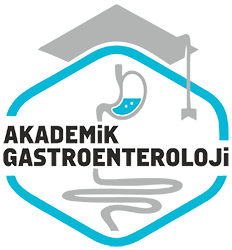Sirozlu hastalarda Q-T araligindaki degisıklıkler
Q-T interval prolongation in cirrhotic patients
Pamukkale Üniversitesi Tip Fakültesi Iç hastaliklari Bilim Dali2, Gastroenteroloji Bilim Dali3 ve Biyokimya Bilim Dali4, Denizli
Özet
Giriş ve amaç: Karaciger sirozlu olgularda aritmiler, ani kardiyak ölümler sik görülmektedir. Uzamis Q-T araligi karaciger sirozlu olgularda kardiyak ritim problemlerinden sorumlu olabilir. Biz bu çalışmada karaciger sirozlu olgularda Q-T mesafesini, bunun karaciger hastalığınin nedeni ve şiddeti ile ilişkisini araştırmayı amaçladık. Gereç ve yöntem: çalışmaya bilinen kalp hastalığı olmayan 65 karaciger sirozlu olgu (yaş 40-72) ve kontrol grubu olarak 45 sağlıklı olgu (yaş 45-60) alındı. Olgularin karaciger fonksiyon testleri, serum elektrolit, üre, kreatinin ölçümleri yapildi. Karaciger sirozunun derecesi Child-Pugh kriterlerine göre belirlendi. Tüm olgularin EKG kayitlarindan Bazet formulüne göre düzeltilmis Q-T (Q-Tc) mesafesi hesaplandi. Bulgular: Sirozlu olgularda Q-T araligi kontrol grubundan anlamli oranda daha uzun saptandi (437± 2,9 ms ve 365±2,8 ms p<001). Q-T mesafesi hastalığın şiddeti (r:0.53, p<0.05), ve prothrombin zamani ile (r:0.60, p<0.001) pozitif ilişki gösterirken serum albumin düzeyi ile negatif ilişki saptandi (r:- 0.40, p<0.001) Alkolik ve viral hepatite bagli siroz olgulari arasında QT mesafesi arasında anlamli fark mevcut degildi. Sonuç: Sirozlu olgularda Q-T araligi ölçümleri Hastaların takibinde kullanilabilecek ve prognoz kriterlerine dahil edilebilecek önemli bir gösterge olabilir.
Abstract
Background and aims: A prolonged Q-T interval is a risk factor for cardiac arrhythmias and sudden cardiac arrest. In this study, Q-T interval changes in cirrhotic patients at different stages and with different etiologic factors was evaluated. Possible causes of Q-T wave abnormality in cirrhotic patients were also evaluated. Materials and methods: Sixty five cirrhotic patients (40-72 years old) and 45 healthy volunteer subjects (45-60 years old) were included in the study. Liver function tests in addition to complete blood count, serum electrolytes, creatinine, prothrombin time and thyroid functions were also measured. Ascites was evaluated by ultrasound examination, encephalopathy history was recorded for each patient and stages of cirrhotic patients were graded according to Child- Pugh’s criteria. The Q-T interval was calculated according to the Bazet formula. Results: The Q-T interval was longer in cirrhotic patients (437±2.9 ms versus 365±2.8 ms p<001). It was positively correlated with prothrombin time and negatively associated with serum albumin level. The etiology of cirrhosis did not seem to effect the Q-T interval. Conclusion: These results indicate that the Q-T interval is closely associated with severity of liver disease independent from the etiology of the disease. Assessment of the Q-T interval is simple test that could be used in the follow-up of cirrhotic patients



